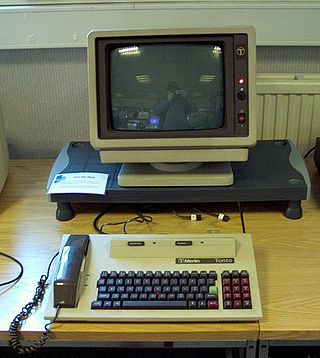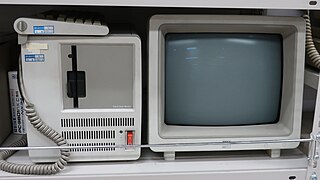
The IBM 3270 is a family of block oriented display and printer computer terminals introduced by IBM in 1971 and normally used to communicate with IBM mainframes. The 3270 was the successor to the IBM 2260 display terminal. Due to the text color on the original models, these terminals are informally known as green screen terminals. Unlike a character-oriented terminal, the 3270 minimizes the number of I/O interrupts required by transferring large blocks of data known as data streams, and uses a high speed proprietary communications interface, using coaxial cable.

A mainframe computer, informally called a mainframe or big iron, is a computer used primarily by large organizations for critical applications like bulk data processing for tasks such as censuses, industry and consumer statistics, enterprise resource planning, and large-scale transaction processing. A mainframe computer is large but not as large as a supercomputer and has more processing power than some other classes of computers, such as minicomputers, servers, workstations, and personal computers. Most large-scale computer-system architectures were established in the 1960s, but they continue to evolve. Mainframe computers are often used as servers.

3Com Corporation was an American digital electronics manufacturer best known for its computer network products. The company was co-founded in 1979 by Robert Metcalfe, Howard Charney and others. Bill Krause joined as President in 1981. Metcalfe explained the name 3Com was a contraction of "Computer Communication Compatibility", with its focus on Ethernet technology that he had co-invented, which enabled the networking of computers.

A terminal emulator, or terminal application, is a computer program that emulates a video terminal within some other display architecture. Though typically synonymous with a shell or text terminal, the term terminal covers all remote terminals, including graphical interfaces. A terminal emulator inside a graphical user interface is often called a terminal window.
Systems Network Architecture (SNA) is IBM's proprietary networking architecture, created in 1974. It is a complete protocol stack for interconnecting computers and their resources. SNA describes formats and protocols but, in itself, is not a piece of software. The implementation of SNA takes the form of various communications packages, most notably Virtual Telecommunications Access Method (VTAM), the mainframe software package for SNA communications.

A computer terminal is an electronic or electromechanical hardware device that can be used for entering data into, and transcribing data from, a computer or a computing system. Most early computers only had a front panel to input or display bits and had to be connected to a terminal to print or input text through a keyboard. Teleprinters were used as early-day hard-copy terminals and predated the use of a computer screen by decades. The computer would typically transmit a line of data which would be printed on paper, and accept a line of data from a keyboard over a serial or other interface. Starting in the mid-1970s with microcomputers such as the Sphere 1, Sol-20, and Apple I, display circuitry and keyboards began to be integrated into personal and workstation computer systems, with the computer handling character generation and outputting to a CRT display such as a computer monitor or, sometimes, a consumer TV, but most larger computers continued to require terminals.
Attachmate Corporation is a 1982-founded software company which focused on secure terminal emulation, legacy integration, and managed file transfer software. Citrix-compatibility and Attachment Reflection were enhanced/added offerings.

The One Per Desk, or OPD, was a British innovative hybrid personal computer and telecommunications terminal based on the hardware of the Sinclair QL. The One Per Desk was built by International Computers Limited (ICL) and launched in the United Kingdom in 1984. It was the result of a collaborative project between ICL, Sinclair Research and British Telecom, begun in 1983, which originally intended to incorporate Sinclair's flat-screen CRT technology.

A 3270 Emulator is a terminal emulator that duplicates the functions of an IBM 3270 mainframe computer terminal on a computer, usually a PC or similar microcomputer.

Irma board, originally spelled IRMA board, refers to a brand of coaxial interface cards for PCs and Macintosh computers used to enable 3270 emulator programs to connect to IBM mainframe computers. IRMA boards were used to connect PCs and Macs to IBM 3274 terminal controllers.
Since the rise of the personal computer in the 1980s, IBM and other vendors have created PC-based IBM mainframe-compatible systems which are compatible with the larger IBM mainframe computers. For a period of time PC-based mainframe-compatible systems had a lower price and did not require as much electricity or floor space. However, they sacrificed performance and were not as dependable as mainframe-class hardware. These products have been popular with mainframe developers, in education and training settings, for very small companies with non-critical processing, and in certain disaster relief roles.

The IBM 3270 PC, is a personal computer developed by IBM and released in October 1983. Although its hardware is mostly identical to the IBM PC XT, the 3270 contains additional components that, in combination with software, can emulate the behavior of an IBM 3270 terminal. Therefore, it can be used both as a standalone computer, and as a terminal to a mainframe.
Relay Gold is a terminal emulator software program that supports modem transmission and mainframe file transfer. It was developed by Microcom, and marketed by Relay Technology until its acquisition in the late 1990s by NetManage.

IBM 5550 is a personal computer series that IBM marketed in Japan, Korea, Taiwan and China in the 1980s and 1990s, for business use customers. In Japan, it was introduced in 1983 and promoted as "Multistation 5550 (マルチステーション5550)" because it had three roles in one machine: a PC, a word processing machine which was traditionally marketed as a machine different from a PC in Japan, and an IBM-host attached terminal.
Crosstalk Mk.4 was a commercially available PC telecommunications and terminal emulation software package originally produced by Atlanta-based Crosstalk Communications, from the late 1980s through 1990, and by Digital Communications Associates (DCA) until the mid-1990s. Crosstalk Mk.4 was one of a suite of products produced by the company; others included the famed Crosstalk XVI, Crosstalk Communicator, Crosstalk for Windows, and Remote 2.

Rumba is a terminal emulation software program with user interface (UI) modernization properties. Rumba and Rumba+ allow users to connect to legacy systems via desktop, web, and mobile. Rumba provides IT end users with a modern UI, allowing them to bypass green screen applications.

The IBM Personal Computer XT is the second computer in the IBM Personal Computer line, released on March 8, 1983. Except for the addition of a built-in hard drive and extra expansion slots, it is very similar to the original IBM PC model 5150 from 1981.

Informer Computer Terminals, Inc., originally Informer, Inc., and later Informer Computer Systems, Inc., was a privately held American computer company active from 1971 to 2007. It manufactured data terminals that could communicate with mainframes and minicomputers, mainly those manufactured by IBM and Digital. It was originally based in Los Angeles, California; in the early 1980s, it moved to Laguna Beach, and in the late 1980s, to Garden Grove.
3R Computers, Inc., or RRR Computers, Inc., later Avatar Technologies, was an American computer company based in Westborough, Massachusetts, known for their Avatar series of dumb terminal-to-workstation devices.
Lee Data Corporation was an American computer company based in Eden Prairie, Minnesota, and active as a hardware company from 1979 to 1990. It was principally founded by John M. Lee and John Roy to sell data terminal systems compatible with the IBM 3270. It found success going into the mid-1980s, with its offerings praised for their innovations and lower prices compared to IBM's 3270 line, but began faltering in the late 1980s when IBM themselves began adopting such innovations.













